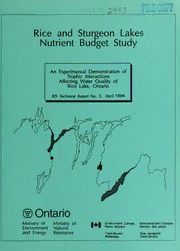
An Experimental Demonstration of Trophic Interactions Affecting Water Quality of Rice Lake, Ontario R/S Tr No 5 PDF
Preview An Experimental Demonstration of Trophic Interactions Affecting Water Quality of Rice Lake, Ontario R/S Tr No 5
^'1^.3 Rice and Sturgeon Lakes Nutrient Buoget Study An Experimental Demonstration of Trophic Interactions Affecting Water Quality of Rice Lake, Ontario R/S Technical Report No. 5, April 1994 ® Ontario Ministry of Ministry of 1^1 Environment Canada Environnement Canada Environment Natural Parks Service Service des parcs and Energy Resources Tmrrt-Sevem Voie navigable Waterway Trent-Severn ISBN0-7778-2528-7 ANEXPERIMENTAL DEMONSTRATION OF TROPHIC INTERACTIONS AFFECTING WATER QUALITY OFRICE LAKE, ONTARIO APRIL 1994 Cettepublication technique n'est disponible qu'en anglais. Copyright: Queen's Printer for Ontario, 1994 This publication may be reproduced for non-commercial purjwses with appropriate attribution. PIBS 2993 AN EXPERIMENTAL DEMONSTRATION OF TROPHIC INTERACTIONS AFFECTING WATER QUALITY OFRICE LAKE, ONTARIO Reportprepared by: K.H. NichoUs MGEE Aquatic Science Section, 125 Resources Road ON Etobicoke, M.F.P. Michalski Michael Michalski Associates P.O. Box 367 ON Bracebridge, and W. Gibson Blackburn Hall Trent University ON Peterborough, PREFACE The Kawartha lakes are a large and economically important system of eight lakes which are located in central Ontario. Sturgeon Lake and Rice Lake are located nearthe upper and lower ends ofthe Kawartha Lakes system respectively and both support significant amounts of urban and recreational development. They were chosen for detailed study because of their importance within the system and because both have shown the symptoms associated with excessive nutrient input for several years. The Rice and Sturgeon Lakes Nutrient Budget Studywas initiated to investigate linkages between pointand non-pointsourcesofnutrients, waterquality, and aquaticlifewithinthe lakes and to estimate the impacts ofthese processes on in-lake and downstream water quality. The study was supervised by the Rice - Sturgeon Lakes Nutrient Budget Technical Committee which had representatives from the Limnology Section (Water Resources Branch) and Central Region of the Ministry of the Environment, the Trent Severn Waterway (Environment Canada) and the Kawartha Lakes Fisheries Assessment Unit of the Ministry of Natural Resources. This is one of a series of technical reports. These and the summary report (R/S Tech. Rep. No. 13) will provide a technical basis for the management of the Rice Lake and Sturgeon Lake ecosystems and forthe use of landandwater resources in the Kawartha Lakes region in general. A list of all reports in the R/S Tech. Rep. series is as follows: 1. Hutchinson N.J., B.J. Clark, J.R. Munroand B.P. Neary 1994. Hydrological datafor the watersheds of Rice Lake and Sturgeon Lake.1986 - 1989, 100 pp. 2. Hutchinson N.J., J.R. Munro, B.J. Clark and B.P. Neary. 1994. Waterchemistry data for Rice Lake, Sturgeon Lake andtheir respective catchments 1986-1989, 169 pp. 3. Hutchinson N.J., B.J. Clark J.R. Munro and B.P. Neary, 1994. Nutrient Budget data forthe watersheds of Rice Lake and Sturgeon Lake. 120 pp. 4. Ryback, M. and I. Rybak. 1994. Sediment pigment stratigraphy as evidence of long term changes in primary productivity of Sturgeon and Rice Lakes (Kawartha Lakes). 24 pp. 5. Nichofis, K.H., M.F.P. Michalski and W. Gibson. 1994. Trophic interactions in Rice Lake I: An experimental demonstration of effects on water quality. 6. Limnos Ltd. 1994. Partitioning of phosphorus in Potamogeton crispus. 22 pp. 7. Limnos Ltd. 1994. Rice Lake Macrophytes: distribution, composition, biomass,tissue nutrient content and ecological significance. 123 pp. 8. Beak Consultants Ltd. 1994. Release of phosphorus from Rice Lake sediments. 31 pp- 9. Limnos Ltd., Michael Michalski Associates and D.J. McQueen. 1994. Trophic interactions in Rice Lake II.Young-of-the-yearyellowperch-Daphnia interactions, preliminary findings. 101 pp. 10. Badgery, J.E., D.J. McQueen, K.H. Nicholls and P.R.H. Schaap. 1994. Trophic interactions in Rice Lake III: Potential for biomanipulation. 1988 and 1989 . 11. Standke, S. 1994. The zooplankton of Rice Lake and Sturgeon Lakes, 1986-1988, Kawartha Lakes, Ontario . 12. Nicholls, K.H. 1994. The phytoplankton -water quality relationships offhe Kawartha Lakes, 1972-1989. 13. Hutchinson, N.J., K.H. Nicholls and S. Maude, 1994. Rice and Sturgeon Lake Nutrient Study: Summary and recommendations. ABSTRACT Eight cylindrical enclosures (3m diameter, 2.7m long, V= 20m^) were installed in eutrophic Rice Lake (Ontario, Canada) in late spring of 1987. Fish (yearling yellowperch (Percaflavescens andmacrophytes (Potamogetoncrispus presenceandabsencewere ) ) set atthe beginning ofthe experimenttoyieldfourcombinations ofduplicatetreatments. The main purposeoftheexperimentwasto determine ifthe phytoplankton, zooplankton, macrophytes and fish species resident in the lake interactto significantly influence water quality. Thepresenceoffishhadthefollowingdirecteffects: 1) decreasedbiomassoftotal zooplankton, 2) decreased number of species in the zooplankton, and 3) decreased average size of several zooplankton taxa, which indirectly contributed to significantly higher phytoplankton biomass. Large Daphnia species were best correlated with this algal response (r^ = 0.995) and were associated with reduced biomass of several algal species including some largeforms (Mougeotia Oedogonium and several colonial blue- . . greenalgae). However, nosignificantcontroloflatesummergrowthofthebloom-forming blue-green algaAnabaenaplanctonica Brun, was achieved bythe Daphnia presence-fish absence treatment. The presence or absence of macrophytes had little apparent effect on the trophic interactions among fish, zooplankton and phytoplankton, but influenced greatly the inorganic chemistry (major ions, pH) of the enclosed lakewater through regulation of CaCOg equilibrium and leaching of cell constituents (especially potassium) during plant senescence. Release of phosphorus to the water column during the die- back ofthe P. crispus population was not an important phenomenon. TABLE OF CONTENTS Preface . • • •. ' Abstract • • • • • • '" List ofTables . • • • • ^ List of Figures -, ^' Introduction 1 Materials and Methods >. ^ -3 Installation and Maintenance of Enclosures 3 Water Sampling and Analytical Metfiods 4 6 Results Discussion • • • • ^^ Majorions • 10 Phosphorus I"! Biotic Interactions 13 Acknowledgements 15 References "IS IV
